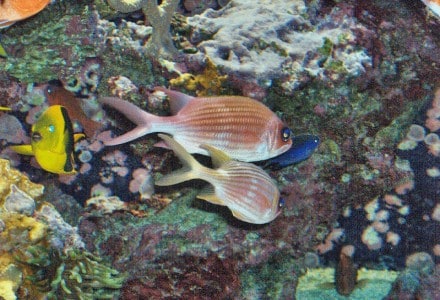
Longspine Squirrelfish Facts
- Firstly, the term Longspine Squirrelfish represents the collective name for a genus of small tropical fish. There also appear to be roughly 150 species within this genus, which forms a small order of beryciformes.
- Unfortunately for the species, however, it now constitutes a highly popular fish in the majority of public aquariums. This unfortunate effect of its popularity occurs due to its bright coloring.
- The Longspine Squirrelfish also remains a highly territorial species within its native environment. It often aggressively defends what it perceives as its territory from all invaders.
- It also actually appears to be capable of vocalizing sounds. This fact sets it apart from most known fish. Further, these unique sounds seem similar to a series of staccatos or grunts.
- These the individuals utilize to defend their territory. Further, the animal often works together in large groups to defend against even such predators as the dragon moray eel.
Related Articles
Longspine Squirrelfish Physical Description
Most notably, the Longspine Squirrelfish remains an often brilliantly colored species of ocean fish. Individual color patterns also vary. But, these typically consist of orange to gold stripes on a background of silvery red.
Furthermore, its eyes develop as comparatively large. However, this appears to be a typical trait of all squirrelfish. In addition, adults generally average about 7.8 in (18 cm) in overall length.
This species also develops a highly elongated third spine on its anal fin. The physical feature serves as the source of the common name for the species.
- Kingdom: Animalia
- Phylum: Chordata
- Class: Actinopterygii
- Order: Beryciformes
- Family: Holocentridae
- Genus: Holocentrus
- Species: H. rufus
Longspine Squirrelfish Distribution, Habitat, and Ecology
The majority of individuals of the rather uniquely named Longspine Squirrelfish live along the eastern coast of the United States, in North America. But some live as far away as the coastal regions of northern portions of South America.
In addition to this, small, isolated populations also exist in other regions. Yet the majority of these scattered pockets of the species exist in the West Indies and Bermuda.
It primarily inhabits specific types of habitat in both temperate and tropical regions. There, it will nearly always be found thriving among coral reefs. There, its vocalizations primarily serve as a means of defending its territory from intruders.
Finally, this animal, like others in its genus of fish, is primarily a nocturnal feeder. It feeds opportunistically, but most typically dines upon small prey, including mollusks, gastropods, and crustaceans.
Species Sharing Its Range
Blue Shark American Lobster Sea Spider
Check out our other articles on 5 Rare Mind-Blowing Cloud Types, Lower Keys Marsh Rabbit, Boiling Lake, Turbinicarpus alonsoi, Olive Ridley Sea Turtle, American Wintergreen

